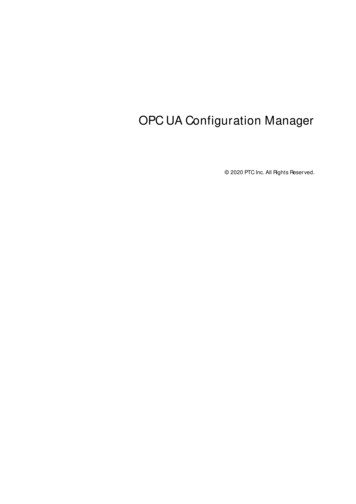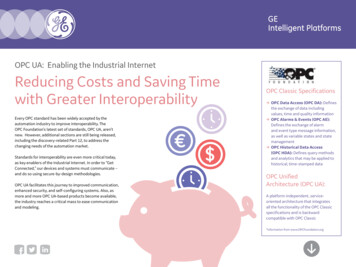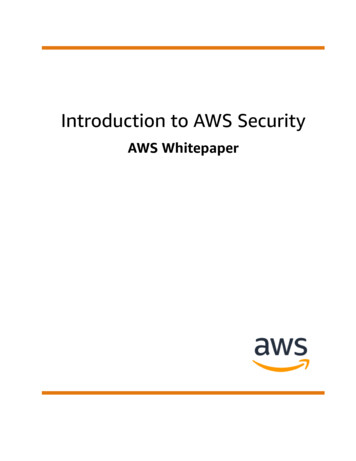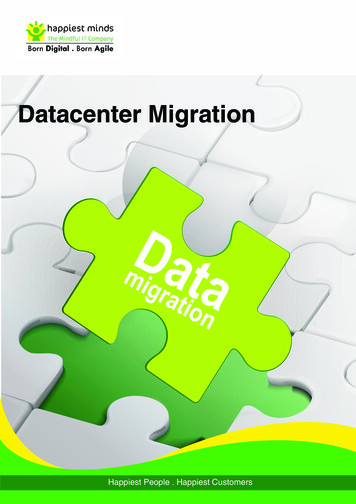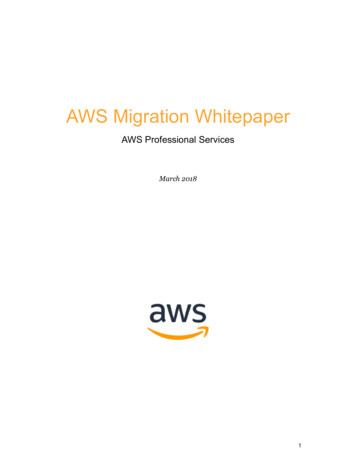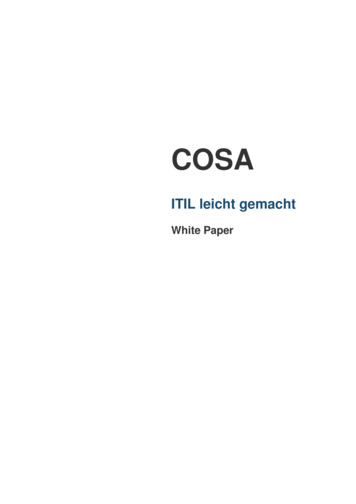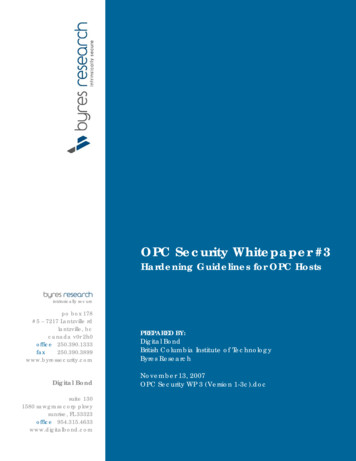
Transcription
OPC Security Whitepaper #3Hardening Guidelines for OPC Hostsintrinsically securepo box 178#5 – 7217 Lantzville rdlantzville, bccanada v0r 2h0office gital Bondsuite 1301580 sawgrass corp pkwysunrise, FL 33323office 954.315.4633www.digitalbond.comPREPARED BY:Digital BondBritish Columbia Institute of TechnologyByres ResearchNovember 13, 2007OPC Security WP 3 (Version 1-3c).doc
Revision HistoryRevisionDateAuthorsDetails0.71.0May 15, 2006May 31, 2006Draft internal review versionDraft for controlled public review1.11.21.31.3aAugust 31, 2006February 9, 2007June 28, 2007August 31, 2007E. Byres, M Franz,E. Byres, J. Carter, MFranzE. Byres, M. FranzE. Byres, D. PetersonE. Byres, D. PetersonE. Byres, D. Peterson1.3bSeptember 9,2007November 13,20071.3cE. Byres, D. PetersonE. Byres, D. Peterson2nd Draft for controlled public review3rd Draft for controlled public review4th Draft for controlled public review5th Draft for final DHS review. Includescomments from the DHSRecommended Practices GroupCorrection of minor grammaticalerrors and added figures to Section 3.6Correction of minor editorial errorsAcknowledgementsThe Group for Advanced Information Technology (GAIT) at the BritishColumbia Institute of Technology (BCIT), Digital Bond, and Byres Researchwould like to thank all the vendors and end users that generously supportedour efforts through numerous interviews and by providing us with documentsthat could only be described as extremely sensitive. Unfortunately we cannot name you for obvious security reasons, but we appreciate your time, trustand encouragement.Several people stood out in their contributions and advice for this documentthat we would like to acknowledge. First are Bill Cotter of MSMUG and ChipLee of ISA - we thank you for all your help in making the user surveys possible.We would also like to thank Ralph Langner for providing the four examplescenarios for this report and lots of useful information on OPC vulnerabilities.Finally we would like to thank Evan Hand for his vision and support. Withouthim, this project never would have been possible.DisclaimerDeployment or application of any of the opinions, suggestions orconfiguration included in this report are the sole responsibility of the readerand are offered without warrantee of any kind by the authors.Since OPC deployments can vary widely, it is essential that any of therecommendations in this report be tested on a non-critical test system beforebeing deployed in a live control system.OPC Security WP 3 (Version 1-3c).dociiNovember 2007
Table of ContentsExecutive Summary. 11 Introduction. 41.1The Issues. 41.2Organization of OPC White Paper Series. 61.3Study Methodology. 61.4Limitations of this Study . 72 Hardening Strategy for OPC Hosts . 93 General Windows Hardening Recommendations . 113.1Patch Management for OPC Hosts . 113.2Minimum Required Services. 123.3Limiting User Privileges. 133.4Limiting Network Access. 143.4.1Creating the Filter Lists . 143.4.2Creating the Block Action . 163.4.3Creating the Security Policy . 163.4.4Assigning the Security Policy . 173.5Protecting the Registry. 173.6Some Special Considerations for XP Systems . 194 OPC/DCOM/RPC Hardening Recommendations . 214.1OPC Hardening Recommendations . 214.2DCOM Hardening Recommendations . 224.2.1Controlling the Authentication Level . 244.2.2Controlling the Location . 254.2.3Managing DCOM Permissions. 254.2.4Limiting RPC Ports and Protocols . 274.2.5Setting the OPC Application’s Account . 294.3RPC Hardening Recommendations . 294.3.1Restricting Transport Protocols to TCP . 294.3.2Restricting TCP Port Ranges . 304.4More Special Considerations for XP Systems. 325 OPC Host Hardening Verification. 345.1Windows Service and Open Port Determination . 345.2Windows Event Log Analysis . 355.3Vulnerability Scanning . 365.3.1Microsoft Security Baseline Analyzer 2.0 . 365.3.2Nessus Vulnerability Scanner . 375.3.3Audit Files for Nessus Vulnerability Scanner. 396 A Summary of OPC Host Hardening Practises . 406.1An Action Plan for Hardening OPC Hosts . 40OPC Security WP 3 (Version 1-3c).dociiiNovember 2007
6.2Summary of High Risk Vulnerabilities and Mitigating Good Practices416.3Some Final Thoughts. 437 Areas for More Research in OPC Security. 447.1Firewall and Network Related Solutions for OPC Security. 447.2OPC Tunnelling Solutions for Security Robustness. 447.3Network Intrusion Detection/Intrusion Prevention Signatures. 447.4Enhancements to Network Vulnerability Scanners . 447.5Research Implementation Vulnerabilities in OPC Components . 447.6Use of Domain Isolation in Control Environments . 45Glossary. 46OPC Security WP 3 (Version 1-3c).docivNovember 2007
Executive SummaryIn recent years, Supervisory Control and Data Acquisition (SCADA), processcontrol and industrial manufacturing systems have increasingly relied oncommercial Information Technologies (IT) such as Ethernet , TransmissionControl Protocol/Internet Protocol (TCP/IP) and Windows for both criticaland non-critical communications. This has made the interfacing of industrialcontrol equipment much easier, but has resulted in significantly less isolationfrom the outside world, resulting in the increased risk of cyber-based attacksimpacting industrial production and human safety.Nowhere is this benefit/risk combination more pronounced than the widespread adoption of OLE for Process Control (OPC). OPC is increasingly beingused to interconnect Human Machine Interface (HMI) workstations, datahistorians and other hosts on the control network with enterprise databases,Enterprise Resource Planning (ERP) systems and other business orientedsoftware. Unfortunately, securely deploying OPC applications has proven tobe a challenge for most engineers and technicians. While OPC is an openprotocol with specifications freely available, engineers must wade through alarge amount of very detailed information to answer even the most basicOPC security questions.To address this need for security guidance on OPC deployment, a jointresearch team with staff from BCIT, Byres Research and Digital Bond werecommissioned by Kraft Foods Inc. to investigate current practices for OPCsecurity. The results of this study were then used to create three white papersthat:1. Provide an overview of OPC technology and how it is actuallydeployed in industry2. Outline the risks and vulnerabilities incurred in deploying OPC in acontrol environment3. Summarizes current good practices for securing OPC applicationsrunning on Windows-based hosts.The white paper you are now reading is the last of the three, and outlineshow a server or workstation running OPC can be secured in a simple andeffective manner. Typically this “hardening” must be conducted in severalstages. First the operating system (typically Windows) needs to be “lockeddown” in such a manner that will make it less susceptible to common O/Sbased attacks. This involves five steps which are:1. Ensuring up-to-date patching of the operating system and applicationson the OPC host;2. Limiting services to the required minimum for OPC;OPC Security WP 3 (Version 1-3c).doc1November 2007
3. Defining user accounts and privileges;4. Limiting network access via the Windows Firewall;5. Protecting the Windows Registry.Next, the specific OPC components must be hardened using the OPC andDCOM configuration tools found in Windows. Unfortunately, completing thisstage successfully is more complex; our testing indicated that there are anumber of OPC applications that do not properly follow the DCOMspecifications for Windows software. As a result, several of the stepssuggested below may cause a malfunction of these OPC applications. Thuswe suggest the OPC user consider the seven steps listed below as a menu tochoose from rather than a list of unalterable requirements:1. Controlling the authentication levels for various OPC actions;2. Controlling the location of various OPC actions;3. Managing the DCOM Permissions;4. Limiting protocols used by DCOM/RPC and setting a Static TCP port;5. Setting appropriate OPC servers accounts;6. Restricting Transport Protocols for RPC;7. Restricting TCP Port Ranges for RPC.Of these seven, perhaps the most unusual is step 4, as it gives the end-userthe opportunity to address one of the more vexing problems in OPC security,namely the problem of dynamic port allocation. Unfortunately it was alsothe solution most likely to cause issues with OPC software, since it wasapparent that not all vendors of OPC products respect the static setting ofport numbers. Thus we also provided step 7 as alternative method for portrestriction, in case task 4 does not work correctly on your OPC software.Next, the system needs to be tested to ensure these changes still allow allOPC applications to function correctly. Since we found a number of caseswhere OPC vendors were not respecting DCOM security settings andrequirements, this testing is critical before any security settings are deployedon live production systems.Lastly, verification of the fortifying effort is required to ensure no serioussecurity holes have been left open. This includes the following steps:1. Windows Service and Open Port Determination2. Windows Event Log Analysis3. Vulnerability ScanningThese stages are expanded upon in a detailed Action Plan for HardeningOPC Hosts within this report. Specific examples are also provided for eachOPC Security WP 3 (Version 1-3c).doc2November 2007
task. In all, we believe by following these guidelines, the typical controlstechnician will be able to create a more secure and robust OPC deploymenton their plant floor and OPC can continue to grow as a valuable solution inindustrial data communications.OPC Security WP 3 (Version 1-3c).doc3November 2007
1 IntroductionThis report is the third of three white papers outlining the findings from a studyon OPC security conducted by Byres Research, Digital Bond and the BritishColumbia Institute of Technology (BCIT). The objective of this study was tocreate a series of simple, authoritative white papers that summarized currentgood practices for securing OPC client and server applications running onWindows-based hosts. The full study is divided into three Good PracticeGuides for Securing OPC as follows: OPC Security White Paper #1 – Understanding OPC and How it is Used:An introduction to what OPC is, its basic components and how it isactually deployed in the real world. OPC Security White Paper #2 – OPC Exposed: What are the risks andvulnerabilities incurred in deploying OPC in a control environment? OPC Security White Paper #3 – Hardening Guidelines for OPC Hosts:How can a server or workstation running OPC be secured in a simpleand effective manner?All three white papers are intended to be read and understood by ITadministrators and control systems technicians who have no formalbackground in either Windows programming or security analysis.1.1 The IssuesIn recent years, Supervisory Control and Data Acquisition (SCADA), processcontrol and industrial manufacturing systems have increasingly relied oncommercial information technologies (IT) such as Ethernet , TCP/IP andWindows for both critical and non-critical communications. The use of thesecommon protocols and operating systems has made the interfacing ofindustrial control equipment much easier, but there is now significantly lessisolation from the outside world. Unless the controls engineer takes specificsteps to secure the control system, network security problems from theEnterprise Network (EN) and the world at large will be passed onto theSCADA and Process Control Network (PCN), putting industrial production andhuman safety at risk.The wide-spread adoption of OLE for Process Control (OPC) standards forinterfacing systems on both the plant floor and the business network is aclassic example of both the benefits and risks of adopting IT technologies inthe control world. OPC is an industrial standard based on the MicrosoftDistributed Component Object Model (DCOM) interface of the RPC (RemoteProcedure Call) service. Due to its vendor-neutral position in the industrialcontrols market, OPC is being increasingly used to interconnect HumanOPC Security WP 3 (Version 1-3c).doc4November 2007
Machine Interface (HMI) workstations, data historians and other servers onthe control network with enterprise databases, ERP systems and otherbusiness-oriented software. Furthermore, since most vendors support OPC, it isoften thought of as one of the few universal protocols in the industrial controlsworld, adding to its widespread appeal.Many readers will be aware that the OPC Foundation is developing a newversion of OPC (called OPC Unified Architecture or OPC-UA) that is based onprotocols other than DCOM1. This is in conjunction with Microsoft's goal ofretiring DCOM in favour of the more secure .NET and service-orientedarchitectures. Once most OPC applications make this migration from theDCOM-based architecture to a .NET-based architecture, industry will havethe opportunity for much better security when it comes to OPC, but also anew set of risks.Unfortunately, based on our experience in the industry, it may be a numberof years before many companies actually convert their systems. So, sinceDCOM-based OPC is what is on the plant floor today and will continue to seeuse for years to come, we focused our investigation on how to secure thistype of OPC.Our initial research showed two main areas of security concern for OPCdeployments. The first (and most often quoted in the popular press) is that theunderlying protocols DCOM and RPC can be very vulnerable to attack. Infact, viruses and worms from the IT world may be increasingly focusing on theunderlying RPC/DCOM protocols used by OPC, as noted in this attack trendsdiscussion:“Over the past few months, the two attack vectors that we saw involume were against the Windows DCOM (Distributed ComponentObject Model) interface of the RPC (remote procedure call) serviceand against the Windows LSASS (Local Security Authority SubsystemService). These seem to be the current favorites for virus and wormwriters, and we expect this trend to continue.”2At the same time, news of the vulnerabilities in OPC are starting to reach themainstream press, as seen in the March 2007 eWeek article entitled “HoleFound in Protocol Handling Vital National Infrastructure”3. Thus, the use ofOPC connectivity in control systems and servers leads to the possibility ofDCOM-based protocol attacks disrupting control systems operations.See Whitepaper #1, Section 5.7: OPC Unified Architecture for more information on OPC-UA.Bruce Schneier, “Attack Trends” QUEUE Magazine, Association of Computing Machinery,June 20053 Lisa Vaas, “Hole Found in Protocol Handling Vital National Infrastructure” ,00.asp, March 23, 200712OPC Security WP 3 (Version 1-3c).doc5November 2007
Despite these concerns, it is our belief that the most serious issue for OPC isthat configuring OPC applications securely has proven to be a majorchallenge for most engineers and technicians. Even though OPC is an openprotocol with the specifications freely available, users must wade through alarge amount of very detailed information to answer even basic securityquestions. There is little direct guidance on securing OPC, and our researchindicates that much of what is available may actually be ineffective ormisguided.All things considered, there is little doubt that some clear advice would bevery useful for the control engineer on how best to secure currentlydeployed, COM/DCOM-based OPC systems. This series of white papers aimsto help fill that gap for the end-user.1.2 Organization of OPC White Paper SeriesAs noted earlier, this is the third of three white papers outlining the findingsand recommendations from a study on OPC security. In White Paper #1 wereviewed the OPC specifications, focusing on details that are relevant from asecurity point of view and might be useful to users wishing to understand therisks of OPC deployments. We then described the real-world operation ofOPC applications, identifying components that need to be understood toharden hosts running OPC client and server applications.In White Paper #2 we defined a set of vulnerabilities and possible threats toOPC hosts, based on OPC’s current architecture (i.e. the use of DCOM). Wealso looked at common misconfiguration vulnerabilities found in OPC serveror client computers, both at the operating system and OPC application level.Finally, since the typical OPC host configuration is strongly influenced by theguidance provided by the software vendor, we looked at the quality ofconfiguration utilities and guidance provided to end-users by the OPCvendor community.In White Paper #3, we use this information to give the OPC end-user a seriesof practical recommendations they can draw upon to secure their OPC hostmachines.1.3 Study MethodologyDeveloping the findings and recommendations for all three of the whitepapers required the following four-phase approach to the study:1. Data Gathering Conducting user surveys and collecting information on OPCdeployments in order to get a representative sample of how actualOPC Security WP 3 (Version 1-3c).doc6November 20
5.3.3 Audit Files for Nessus Vulnerability Scanner.39 6 A Summary of OPC Host Hardening Practises.40 6.1 An Action Plan for Hardening OPC Hosts.40 . OPC Security WP 3 (Version 1-3c).doc iv November 2007 6.2 Summary of High
